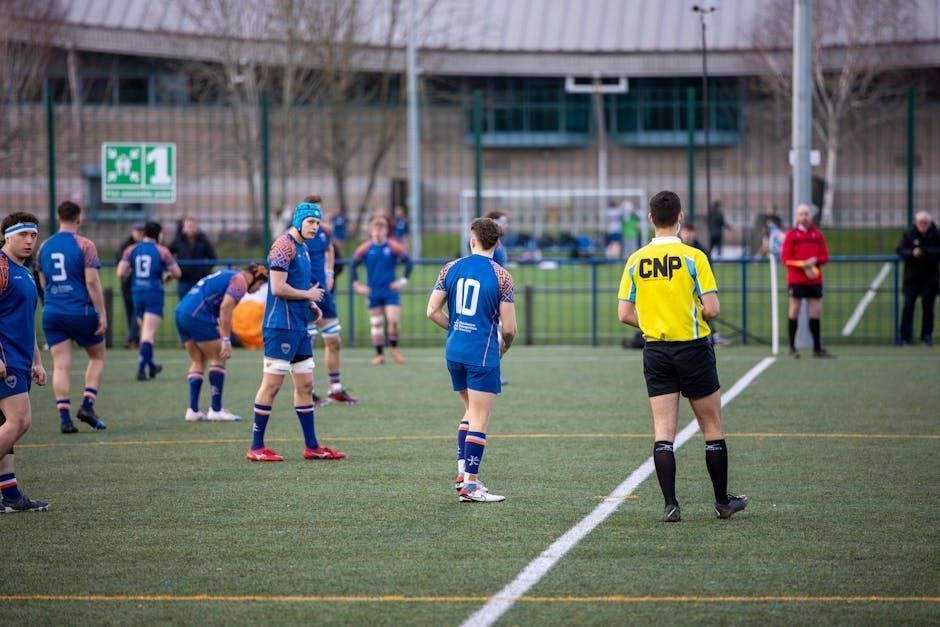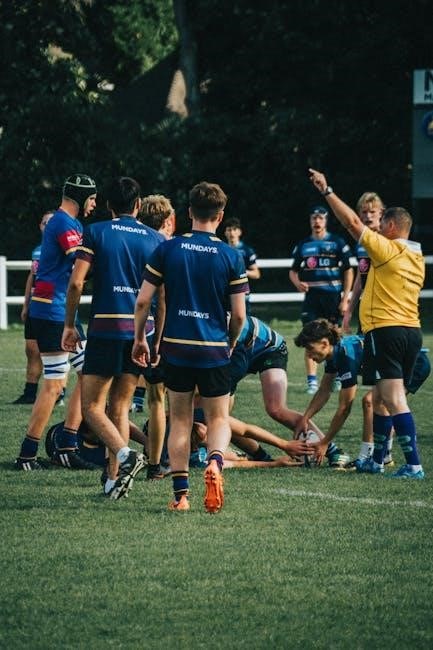rugby league training drills pdf
Rugby league training drills are essential for players to improve skills and techniques, with various drills available online in pdf format for easy access and implementation by coaches and players alike always.
Overview of Rugby League Coaching Manuals
Rugby league coaching manuals are comprehensive resources that provide coaches with a wide range of training drills and techniques to improve player skills and performance. These manuals are often developed by experienced coaches and players, and are designed to be used by coaches at all levels of the game. They typically include a variety of drills and exercises that focus on specific skills such as tackling, passing, and kicking, as well as more general drills that aim to improve overall fitness and teamwork. Many rugby league coaching manuals are available online in pdf format, making it easy for coaches to access and download them. Some manuals also include additional resources such as training plans, game strategies, and player assessment tools. By using these manuals, coaches can create effective training programs that help their players develop the skills and techniques they need to succeed in the game. Rugby league coaching manuals are an essential tool for any coach looking to improve their team’s performance.

Types of Rugby League Training Drills
Various drills include passing, tackling, and kicking exercises to improve skills and techniques always using online resources.
Ruck Drills and Training Games
Ruck drills are a crucial aspect of rugby league training, focusing on improving players’ ability to win the ball back and maintain possession. These drills involve simulated game scenarios, where players practice tackling, wrestling, and regaining control of the ball. Training games, such as touch football and flag football, are also used to develop players’ skills in a more dynamic and interactive environment. By incorporating ruck drills and training games into their practice sessions, coaches can help their players develop the necessary skills and strategies to succeed in rugby league matches. The internet provides a wealth of resources, including pdf files, that outline various ruck drills and training games, making it easier for coaches to plan and implement effective training sessions. These resources can be tailored to suit different age groups and skill levels, ensuring that all players can benefit from participating in ruck drills and training games. Effective implementation of these drills can lead to improved team performance.
Importance of Defence and Tackling Drills
Defence and tackling drills are crucial for rugby league teams to prevent opponents scoring always using online pdf resources effectively.
Kicking Drills and Attacking Drills
Kicking drills and attacking drills are essential components of rugby league training, with various exercises available to improve players’ skills and techniques. Online resources, such as pdf files, provide coaches and players with access to a wide range of drills and training methods. These drills can help players develop their kicking and attacking abilities, including passing, catching, and running with the ball. By incorporating kicking drills and attacking drills into their training sessions, teams can improve their overall performance and increase their chances of winning; Effective kicking and attacking strategies can also help teams to outmaneuver their opponents and create scoring opportunities. With the right training and practice, players can master these skills and become valuable assets to their teams. Kicking drills and attacking drills are critical elements of rugby league training, and teams that prioritize these areas can expect to see significant improvements in their game.

Coaching Tips and Resources
Coaches can access valuable tips and resources online, including pdf guides, to enhance team performance and player development always using trusted sources.
Neil Henry’s Coaching Tips and Handbooks
Neil Henry’s coaching tips and handbooks are highly regarded in the rugby league community, providing valuable insights and strategies for coaches to improve their teams’ performance. His handbooks are comprehensive resources that cover various aspects of the game, including training drills, tactics, and player development. Coaches can benefit from Henry’s expertise and experience, gained from years of coaching at the highest level. The handbooks are designed to be user-friendly, making it easy for coaches to access and implement the tips and drills. With a focus on practical application, the handbooks are an essential tool for coaches looking to enhance their teams’ skills and performance. By following Henry’s coaching tips and using his handbooks, coaches can create a positive and effective training environment that fosters player growth and success. The handbooks are available in various formats, including pdf, making them easily accessible to coaches worldwide.

Role of the NRL MyLeague App in Rugby League Training
The NRL MyLeague App supports rugby league training with resources and tools for players and coaches to improve skills and performance always online.
Coaching Tips from Les Bee, Wayne Goldsmith, Mike Keelan and Warwick Povey
Coaching tips from experienced coaches like Les Bee, Wayne Goldsmith, Mike Keelan, and Warwick Povey are invaluable for rugby league training. These coaches have shared their expertise through various resources, including pdf guides and online tutorials. Their coaching tips cover a range of topics, from catch and pass drills to defensive strategies and attacking plays; By following their advice, coaches can improve their teams’ performance and help players develop their skills. The tips provided by these coaches are based on their years of experience in the sport and are designed to be practical and effective. They can be used by coaches at all levels, from beginner to advanced, and can help to improve the overall quality of rugby league training. With their expertise and guidance, coaches can create effective training programs that help their players succeed. Effective coaching is essential for success in rugby league, and these coaches’ tips can help coaches achieve their goals.

Strength and Conditioning Training for Rugby League Players
Attributes Required for Rugby League Players and How to Incorporate Training
Rugby league players require a range of attributes to perform at their best, including power, speed, size, strength, and agility, which can be developed through targeted training programs.
Effective training incorporates a combination of physical conditioning, skill development, and tactical awareness, allowing players to improve their overall performance.
Players and coaches can access a variety of training resources, including online drills and manuals, to help design and implement effective training programs.
These resources provide valuable guidance on how to structure training sessions, including warm-up routines, skill drills, and conditioning exercises.
By incorporating a well-structured training program, players can develop the attributes required to succeed in rugby league, including endurance, strength, and agility.
Coaches can also use training resources to identify areas for improvement and develop targeted training programs to address these needs.
Overall, a well-designed training program is essential for rugby league players to develop the attributes required to perform at their best.
Players and coaches can use online resources, including pdf guides and training manuals, to access a range of training drills and exercises.
These resources provide a valuable tool for developing effective training programs and improving overall performance.
Effective training is critical for success in rugby league, and players and coaches must be committed to ongoing development and improvement.
By using online resources and training manuals, players and coaches can access a range of training drills and exercises to help improve performance.
Rugby league training drills pdf resources are available online to help players and coaches design and implement effective training programs.








Leave a Comment